- A Look Back
- Partnerships & Coalitions
- Cross-Systems Change
- Multi-Level Regional Strategies
- People Power & Accountability
- Environmental Justice
- Building Capacity
- Policy Wins & Funding Secured
- Story of Climate Progress
- Story of Clean Water
The 2016 – 2020 WEC Strategic Plan took place over the course of arguably some of the most consequential years in American history. This timeframe was bookended by the election of Donald Trump in 2016 and his unprecedented attacks on democratic institutions and environmental protections, and then in 2020, by a global pandemic, long-overdue racial reckoning, and attempts to undermine the outcome of our national elections.
As an organization committed to societal change, these past five years have been a time of both intense advocacy and deep reflection. Given the scale of our environmental challenges and the limited timeline in which we are working, we knew we needed to put all our advocacy tools to work. These tools ranged from policy advocacy in Olympia and at the local level and running a ballot measure to fight carbon pollution, to taking polluters to court, to mobilizing the sheer number of people who wanted to get engaged in response to the Trump administration. It has been inspiring to see so many people committed to taking action for change.
WEC also continued to become a more anti-racist organization. During this time, we grew our analysis and understanding of the ties between systemic racism and environmental degradation. We acknowledge that our 50+ years of advocacy have left many impacted people and communities behind. Our position and power as a historically white-dominant organization necessitate that we apply an intersectional racial justice lens to our framework for change. We made significant shifts in our internal organizational practices as well as our external policy and advocacy work over the course of this plan. This will continue to be a focus area in our next strategic plan.
In the last five years, we evolved how we do our work as the problems we face grow increasingly complex, and, as with many other sectors, in response to the COVID-19 crisis. We have had to adapt, use new tools, maximize existing ones, and move beyond the traditional boundaries of environmental advocacy to achieve the strongest and broadest coalitions possible that can address the root causes of issues we have long worked on. Based on the learnings from these years, we developed a vision for where WEC and our work need to take us, which we share in the final section of the report.
Working in partnership is core to who we are — it is how we started our work in 1967 and it remains fundamental to how we get things done today. We achieved many consequential environmental gains during this Strategic Plan for the long-term future of our state (see Policy Wins & Funding Secured). These gains were made possible by close coordination with our historical partners, and by working deeply with new partners including Tribal Nations, Front & Centered, and other overburdened communities.
Together, in collaboration with agencies and elected officials, community members, and activists, we have made major strides toward achieving our mission: We secured some of the most progressive and equitable climate policies in the nation. We stopped every attempt by Big Oil to expand their footprint in our state. We increased investments in natural systems such green infrastructure to help clean up stormwater pollution, and community forestry to sustainably manage working forests and provide local jobs. We overhauled how we fund and prioritize toxic clean-up and prevention, and we took important steps to help protect and sustain our local Southern Resident orcas.
Throughout the course of our work under this Strategic Plan, WEC deepened our partnership with Washington Conservation Voters, too. The transformational successes achieved during this plan relied on the strategic use of our complementary 501(c)3 and 501(c)4 tools, the investment in significant organizational growth and capacity building, and the leadership of our two organizations under a single CEO with shared staff and two boards of directors who work closely together.
We are proud of our work under this plan and how well it has set us up for the future. Learning from these past four years, we developed a vision for where WEC and our work need to take us, which we share in the final section of the report. We are grateful for the support of the donors, foundations, activists, board members, volunteers, and staff who have brought us this far. In particular, former staff including CEO Joan Crooks, WEC President Becky Kelley and WCV President Shannon Murphy, along with Board Chairs Julie Colehour and Jay Manning, provided the vision and leadership that helped us navigate our work during this tumultuous and exciting time.
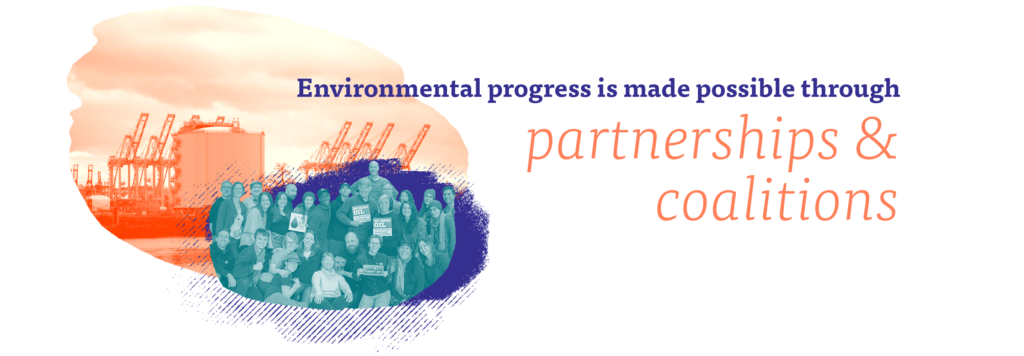
WEC has a long history as a convener and coalition builder in the environmental community. Working with a wide range of partners and allies to align around goals and build power together is fundamental to how we get things done, and has been key for many of our accomplishments over this strategic plan. Collaboration allows us to engage many diverse groups and interests in working toward each win and build networks of power that help draw connections across issue areas.
- We know that we develop more effective and durable policy when we connect the dots with community needs around racial and economic equity. Through the Climate Alliance for Jobs and Clean Energy, we worked with diverse stakeholders to develop the carbon pricing policy for Initiative 1631. While this 2018 ballot measure lost, its nationally recognized racial and economic equity provisions set the stage for future policy wins in our state including 100% Clean Electricity, updated Climate Pollution Limits, and significantly in the 2021 legislative session, the Climate Commitment Act and a new Clean Fuel Standard. Many of the equity principles and provisions developed through these collaborations are built into these new policies. Moving forward, the Climate Alliance will continue to evolve as we shape the path ahead for delivering on these wins.
- I-1631 was driven by the demand for climate action and mobilized the largest and most diverse coalition for a ballot measure in state history, with more than 650 organizations and businesses, along with Tribal Nations, and more than 6,500 volunteers. WEC and our partners launched the Climate Alliance in 2014 and in six years, we substantially shifted the conversation around climate policy in our state and demonstrated that securing a sustainable future for all Washingtonians requires durable, transformative solutions designed in collaboration with the people and communities who are most impacted by the issues — communities of color, Tribal Nations, and workers.
- The power of partnership is also exemplified in our coordinated fossil fuel campaigns work. The successes of Stand Up To Oil, Power Past Coal, and Power Past Fracked Gas rely on well-coordinated, diverse and nimble regional coalitions that leverage the expertise and strategic focus of local, regional, and statewide groups. WEC plays a key role connecting project-specific local grassroots activism with the broader regional fossil fuels landscape and state level clean energy goals. This collaboration elevates local fights into winnable campaigns. Not only have these campaigns so far stopped all proposals for expanded coal, oil and fracked gas infrastructure in our region, but they are developing localized approaches to stop further expansion and focus on a clean energy future as a viable alternative to fossil fuels.
- Collaborating with Tribal Nations is an increasing part of our work. WEC collaborates with a number of Tribal Nations on salmon habitat and Puget Sound recovery, including the Suquamish Tribe and the Port Gamble S’Klallam Tribe on an innovative approach in Kitsap County focused on valuing and managing ecosystem components with their ecological and cultural functions taken into account. We are working with several tribes on reducing pollution from wastewater and turning the Orca Recovery Task Force recommendations into actions. We also coordinate with tribes in our Forests & Fish adaptive management work, particularly the Northwest Indian Fisheries Commission, and we successfully advocated for a tribal seat on the Forest Practices Board.
- Collaborating with local partners in rural communities to develop Community Forestry projects was an important way to drive solutions grounded in meeting their needs. Community Forests are working forests owned and managed by local municipalities, government agencies, Tribes, and/or non-profit organizations for the benefit of local communities. They deliver the triple-bottom line for communities: social, ecological, and economic benefits. WEC successfully advocated the creation of a Community Forests Program in the state Recreation and Conservation Office, and we advocated changes to existing funding sources so that community forests could be eligible. Through these efforts the City of Ilwaco can now move forward on community forest projects to help them acquire and manage land within their watershed. Other projects funded around the state include Mt. Adams, Chewelah, Chimacum Ridge in Jefferson County, and the expansion of Nisqually Community Forest. All told WEC helped to secure nearly $23 million for Community Forests — a first in our state and a shift away from industrial forestry of the past.
- WEC is a respected source of policy expertise and our staff serve on many government task forces, advisory groups, and other policy forums. We use our skills to advocate durable solutions, work to ensure the right people are at the table including directly impacted communities and draw connections between policy development and how we engage advocates and other leaders.
All told we helped to secure nearly $23 million for Community Forests — a first in our state and a step in the right direction away from industrial forestry of the past.
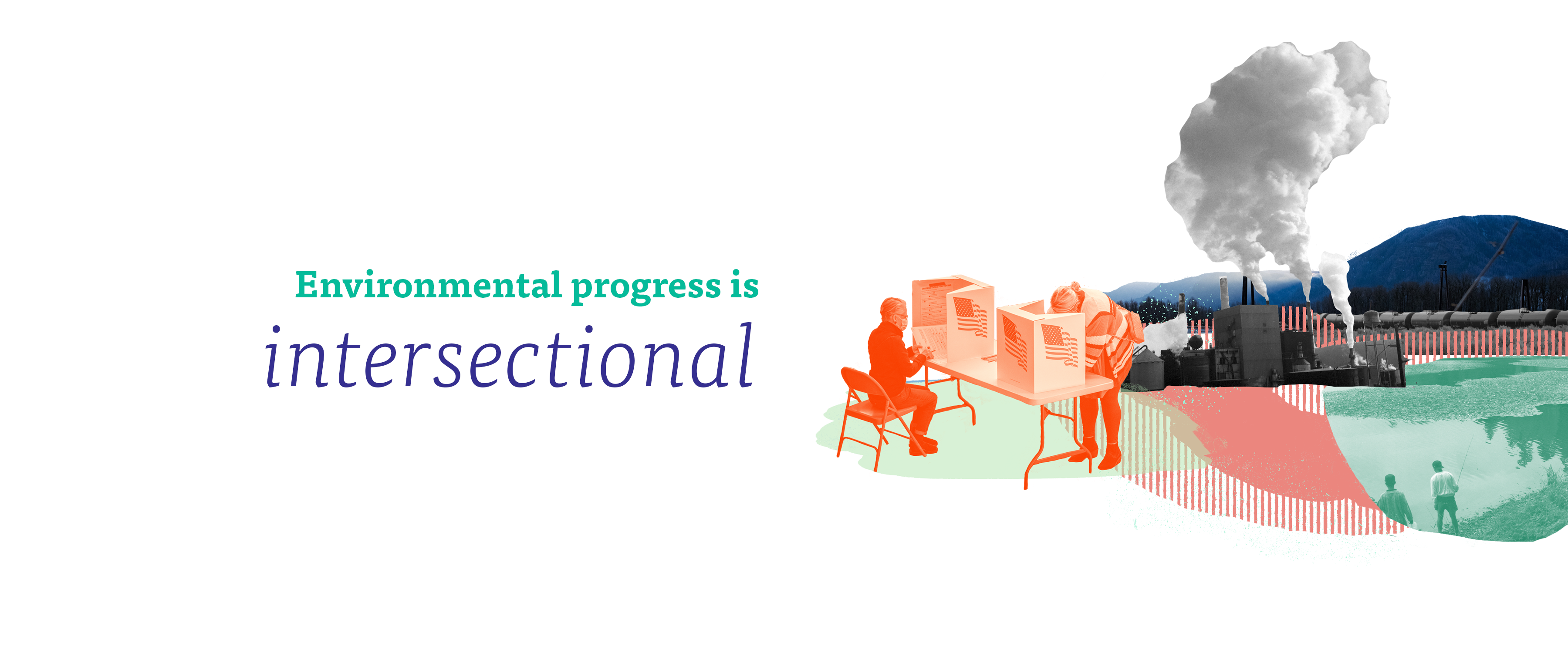
Ecosystems and the environment don’t operate within artificial, human boundaries. We must advance environmental progress across intersecting systems.
- Ecological systems are interwoven in a way that is not often reflected in how they are managed or studied. We are shifting how we work to better reflect these interdependencies. The Kitsap Natural Resource Management project examines resources across program boundaries: forests, healthy streams, and shorelines. Natural Climate Solutions framing reflects that healthy forests, soil, and seas are our best partners in cleaning carbon from our air.
- Our forests also intersect with human systems, whether through our economy, development and housing, or government/regulations. Our Carbon Friendly Forestry Conference brings together policy makers, forestry owners, structural engineers/architects, tribal resource management representatives, and nonprofit organizations to recognize that building systemic solutions to address sustainable forest management and climate change will require cross-sector coordination.
- Our work towards Clean Water for ecosystems and communities demonstrates the intricate ties between forests and the Puget Sound, as well as the organisms and communities who rely on habitat restoration and reduced toxic pollution.
There is no environmental progress without racial justice. We know that the same beliefs, practices, and systems that create and perpetuate interpersonal and institutional racism also create and perpetuate environmental destruction.
WEC has an enduring commitment to update and defend the Model Toxics Control Act (MTCA), which we helped establish in 1988. A fund for toxic cleanup and prevention, MTCA has cleaned up more than 7,000 polluted sites across the state. During the 2016-2020 Strategic Plan, WEC worked to overhaul the law’s funding mechanism to ensure a steady source of revenue and that a racial justice lens is applied to managing funds since low income communities and communities of color are disproportionately impacted by toxic pollution.
A strong and healthy democracy is a cornerstone of environmental progress. We need to ensure a place for everyone in our democracy and support communities pushing for environmental justice.
WEC is a member of the Washington Voting Justice Coalition, where we have pushed for and passed new laws like same day voter registration, automatic voter registration, voting rights re-enfranchisement, and postage paid ballots to lower barriers to voting.
WEC has tested innovative voter outreach strategies, including a shift towards engaging with low frequency voters. Traditional voter outreach frequent voters, but structural barriers to voting often leave young people, communities of color, low income people, and others out of our democratic system. Through innovative voter outreach strategies, we work to reach these low frequency voters in ways that resonate with them. This has helped address a system of inequity in voter outreach and increased voter participation.

Investing in key geographies for the long-term
Throughout our organizational history, WEC has advanced action at the state level and in local communities across Washington. In recent years, we worked to build deeper, long-term relationships in local communities impacted by the policy issues we work on. The evolution of our grassroots outreach during this Plan reflects this shift. Being more consistently present in communities allows us to develop trusting partnerships with local groups, learn about local issues that we could help advance, and identify potential leaders for the future.
Tacoma, Vancouver, and Whatcom County are particularly significant for our clean energy and fossil fuels work, as well as Puget Sound protection work. The local relationships and broad base of support we have developed in those communities over the last five years are the infrastructure for the road ahead.
During this Plan, we built relationships in communities in the Olympic Peninsula, Southwest Washington, and the eastern Cascades to advance a dialogue around funding for working forest conservation easements and build local support for state level community forest efforts.
Building broad cross-regional support for orca recovery
Our biggest barriers to achieving our goals in Puget Sound are public awareness and political will to protect and restore the region and its waters. The tragedy of three young orca deaths in 2018, particularly the dead calf buoyed by her mother, Tahlequah, for 17 days, galvanized more public attention and political will for Puget Sound recovery than at any other time in at least 20 years.
As a member of Governor Inslee’s Orca Recovery Task Force, WEC pushed for a comprehensive set of swift near-term actions and effective long-term actions to address the three main threats to orca recovery: insufficient prey, vessel disturbance, and toxic pollution. We were able to secure a suite of orca recovery bills in 2019 and 2020 addressing all three areas (see Policy Wins & Funding Secured).
We successfully fought to designate Puget Sound as a federally designated No Discharge Zone (NDZ) in 2018, requiring boaters to use pump out facilities for human waste rather than dumping directly in the Sound. With partners, our NDZ advocacy drew over 40,000 public comments, and we celebrated by starting an annual Puget Plunge/Salish Splash with guest appearances by state and local elected officials.
Our “Five Ways to Stand Up For Puget Sound” effort generated over 16,000 actions in 2017, and we have seen even higher levels of engagement every June during annual Orca Month. WEC collaborated with Braided River and the Suquamish Tribe to publish “We Are Puget Sound: Discovering and Recovering the Salish Sea” in 2019, a book and public advocacy campaign on Puget Sound recovery. The book features stories of people from communities around the Sound who are working to protect and restore the region. The book serves as the campaign platform and has reached thousands of people through news media, in-person and online events, and digital outreach. These were not explicitly part of our Strategic Plan, but they have been stunningly successful at engaging new audiences.
Local and state level work is complementary and mutually reinforcing
We know that what happens at the local level affects how state laws are implemented, and local voices can have a big impact on state decisions. This simultaneous upward and downward pressure is critical for environmental progress—we can pass a state law to reduce toxic pollution in Puget Sound, but if local governments aren’t doing the work, it doesn’t get cleaned up.
When we brought local voices into advocacy for state level stormwater infrastructure funding, we were able to secure a significant increase in the Stormwater Financial Assistance Program. Then as those funds were funneled into local communities, more and more local stakeholders saw the benefit of this type of state program.
We are supporting several local communities to update their Climate Action Plans to align with state level policies. After securing 100% Clean Electricity and updating our state’s climate pollution limits, we started looking at how local governments could begin implementation. In Vancouver for example, we are working to strengthen and secure land use code updates under the Growth Management Act, and leverage new clean energy requirements at the local utility and through the City’s Climate Action Plan.
We also engage at the federal level when strategic to maximize the impact of our work.
Our work developing strong climate and clean energy policy has informed conversations around a national 100% Clean Electricity policy.
We work with our federal delegation to make sure Puget Sound recovery is funded.
The courts are still key to upholding existing environmental laws
WEC and our coalition partners use legal action to battle fossil fuel facilities by challenging various permits. Through representation by Earthjustice, these successful legal challenges reaffirmed existing laws and set important precedent around how we measure the potential for future greenhouse gas emissions.
In 2020, WEC and several partners filed a lawsuit against the state regarding how it manages our forested trust lands and the State Supreme Court has accepted review of this case. Our intention is to show that the trust mandate in our State Constitution requires the Department of Natural Resources to manage these lands in the long-term best interests of all Washingtonians; and not only to maximize timber revenue above all other forest benefits. Managing for ecosystem services, including climate change mitigation, are also critical goals.
Together with the Suquamish Tribe and Puget Soundkeeper, we challenged the US Navy for illegally scraping the hull of a decommissioned aircraft carrier in Sinclair Inlet near Bremerton, which released thousands of pounds of toxic materials directly into Puget Sound. In 2020, the courts placed a ten year moratorium on underwater hull cleaning, required any additional hull scraping to occur in dry dock, and ordered the Navy to cover the eight acres of debris polluting the floor of Sinclair Inlet to help recover impacted marine life.

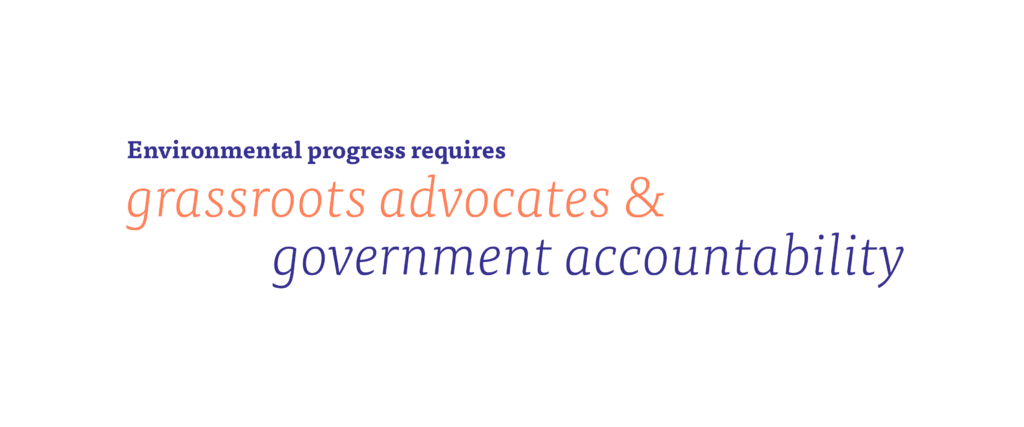
Our expanded field team enabled broader and deeper engagement with activists, and built the momentum needed to secure big wins.
With our coalition partners, we drove strong public displays of opposition to local fossil fuel projects across the region, including Cherry Point, Grays Harbor, Vancouver, and Tacoma. Our organizing work generated unprecedented levels of public participation with over 1 million comments submitted over the last 10 years and record-breaking turnout to public hearings. We built a list of 30,000 activists across the region. In 2018, we successfully defeated Tesoro-Savage, North America’s largest proposed oil-by-rail terminal in Vancouver, WA. We won this highly visible victory after years of local organizing, and a massive wave of coordinated action from multiple sectors: environmental, labor, local community groups, healthcare, business, tribal nations, and more.
2018 was a huge year for our grassroots climate organizing efforts as we grew our supporter base for climate action in Washington alongside Initiative 1631. Our field team engaged thousands of activists, volunteers, and members to build momentum for equitable clean energy in our state. The ideas, activism, and partnerships from this ballot initiative work helped drive legislative wins on climate in 2019 and 2020.
Our expanded team of field organizers helped us evolve from a model of citizen engagement primarily focused on the legislative session to a holistic, year-round approach. We now offer a variety of engagement opportunities on state and local issues, and many different ways for people to participate from one-time digital actions to organizing in their own networks. As a result, more people are willing to take action at different levels of engagement.
WEC relaunched Environmental Lobby Day during this Strategic Plan. In 2019 and 2020 (before the pandemic), this event drew a record 500+ people from 48 of 49 legislative districts in Washington. We mobilized more than 100 activists who came out for public hearings in Olympia and spoke in support of climate action at 13 legislative town halls around the state. We engaged Climate Justice Stewards and partner organizations to distribute 1,200 postcards to friends and family to voice their support for climate action to their legislators.
We used a variety of new organizing tools and technology throughout this Plan for more effective grassroots mobilization, including investing in new texting and phone banking systems that allow us to reach more people more efficiently. We utilized data-driven tactics in our Get Out The Vote, civic engagement, and clean energy organizing efforts We focused on testing strategies to determine which messages, messengers, and modes of contact are most effective for activating various audiences, like low frequency voters or issue-specific activists. During the pandemic, we successfully leveraged virtual organizing strategies to engage even a growing state-wide base in public hearings and other online processes they wouldn’t have been able to attend in person.
WEC is investing organizational resources in helping build the next generation of environmental leaders through our paid field organizing internship program and amplifying the energy of the youth climate movement. We partner with groups such as Our Climate, the Sunrise Movement, and Fridays for the Future, where WEC organizers serve as mentors providing capacity, training, and resources so that the youth can lead.
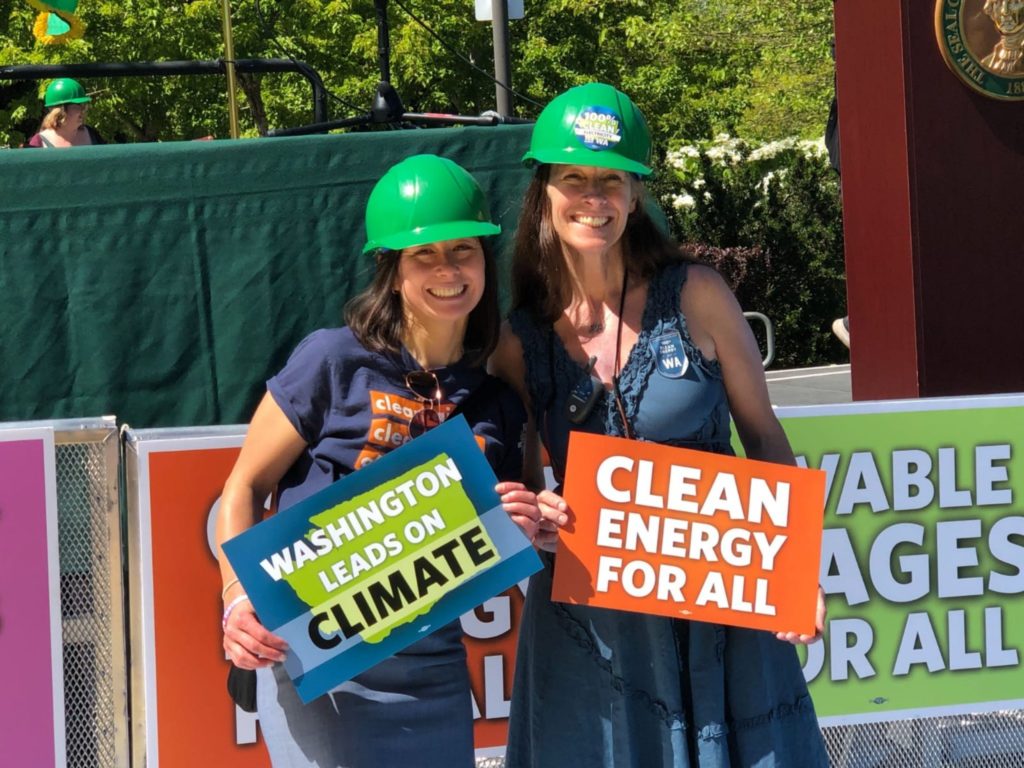
This highly visible victory was won by years of local organizing, and a massive wave of coordinated action from multiple sectors.
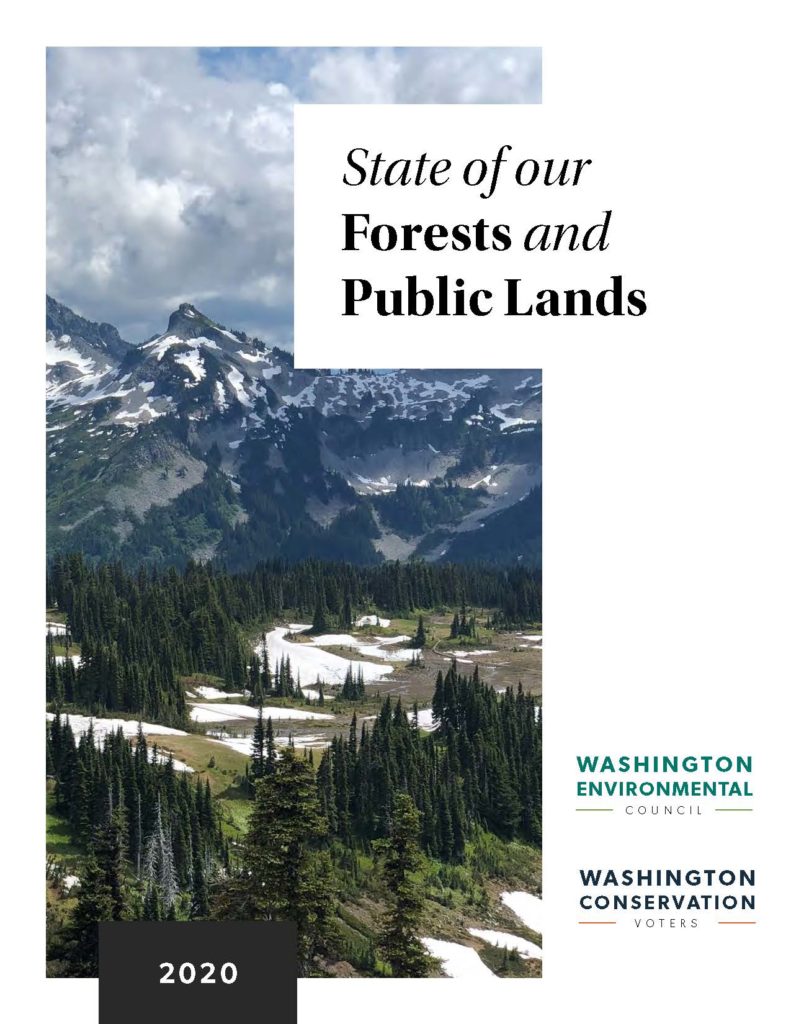
We hold local and state governments accountable for environmental protection using innovative tools
In partnership with Puget Soundkeeper Alliance, we released Nature’s Scorecard in 2017 and 2019 to show how large cities and counties are performing when it comes to using green infrastructure to address stormwater pollution. Only half of Puget Sound’s large municipalities were in compliance with state requirements for low-impact development policies. The scorecard highlights the work of eight “green star” communities that went above and beyond, and challenges underperforming communities to improve their scores. As a direct result of our ratings and digital strategy, 25 local municipalities made measurable improvements to their building codes, requirements, and standards to protect water quality. This brought a total of 80% of Puget Sound municipalities into compliance without litigation.
The annual State of our Forests & Public Lands report card was launched in 2015 as a way to hold the Commissioner of Public Lands accountable. It allows us to communicate priority issues, and has been used by board members, activists, and donors to advocate on behalf of Washington’s forests.
We partner with 501(c)4 Washington Conservation Voters to ensure elected officials are pushing for bold policies at state and local levels. WCV’s work to elect environmental champions is critical to building the political power needed to address some of the biggest environmental issues our state faces. For example, WCV’s electoral work helped reshape the Vancouver Port Commission, influencing the 2018 defeat of the Tesoro Savage mega oil terminal.
WCV’s work to elect environmental champions is critical to building the political power needed to address some of the biggest environmental issues that our state faces
Pursuing Racial & Environmental Justice
An organization that internally embodies just and healthy dynamics can better advocate for similar changes in external systems. This is why our internal racial equity work is essential.
Our position and power as a historically white-dominant organization necessitates that we apply an intersectional, racial justice lens to our existing framework for change. We have made some significant shifts in our internal organizational practices as well as our external policy and advocacy work.
From 2015-2016, WEC staff and board participated in individual and group trainings on race, racism, and whiteness. We used that foundation to create our first Racial Equity Action Plan in 2017, followed by a more comprehensive three-year plan for 2018-2020. This Plan laid out goals for advancing racial equity in four main areas of our work: human resources, organizational culture, coalitions and partnerships, and member education and outreach.
We have radically revamped our Human Resources structures and tools. We require implicit bias training for all hiring panel members, list salaries on all job announcements and do not by default require a college degree. We also include racial justice questions in the interview and follow up process, use a more objective and consistent rating and ranking system for job applicants, changed unpaid internships to paid, pay for individual racial equity training for all new hires, and define racial equity goals for all staff which are evaluated during regular check-ins and annual performance reviews.
We are examining and shifting our organizational culture to dismantle harmful internal practices that are rooted in white supremacy culture. We learn to identify these practices through formal racial equity trainings for individuals as well as all staff, and informally through our Lunch and Learn sessions and sharing readings and insights among staff. We have also begun racial caucusing. We created new opportunities for shared leadership in staff meetings for non-senior level staff and BIPOC staff to facilitate and lead discussions. We have also begun to uplift forms of communication, knowledge, and expression not prioritized by whiteness by sharing art and music, and integrating mindfulness and gratitude practices into our meeting culture.
We have shifted how we engage in and build coalitions and partnerships to ensure that diverse stakeholders, especially the most impacted communities, share decision-making power and collaborate in designing and advocating environmental policy solutions. We helped co-found a roundtable to support anti-racist learning and community building among historically white-dominant organizations. We also created a toolkit that poses critical questions about racial equity, power dynamics, and more for staff to use to assess their work with coalitions and partners.
We continue member education on connections between environmental issues and racial justice. We are working on storytelling as a communications priority and using our social media to focus on amplification. We have created an Event Accessibility checklist which has changed how we organize and host events, including increasing opportunities for all levels of donors. We have also administered surveys to our membership to learn about their baseline understanding of racial equity as it relates to environmentalism.
WEC’s Board Development Committee has been working to advance Board engagement and training around racial equity, including adopting a racial equity plan for 2019-2020 that aligns with WEC’s equity goals. With a new recruitment and onboarding process, the Board has increased its racial diversity and has also begun racial caucusing.
Externally, we are working to build racial equity into environmental policies and systems at all levels of government, and transforming the historically white-dominant environmental community to be more equitable. We recognize that many policies that we and other mainstream environmentalists have advocated were not effective solutions for the people most impacted by pollution and climate change – namely, communities of color and low-income people.
In recent years, we have intentionally shifted our policy development and advocacy to center impacted communities.
During this Strategic Plan, we substantially deepened our relationships with community of color-led organizations and frontline communities in order to develop and advocate stronger, more durable policy that meets the needs of communities overburdened by climate change and pollution. These include Front & Centered and their member organizations, the WA Black Lives Matter Alliance, and the Movement 4 Black Lives. Significantly, we have also made strides in our understanding of Tribal sovereignty and how we need to be engaging with Tribal Nations — this will continue to be a major focus of our work in the years to come.
We have learned critical lessons particularly in our climate work about developing effective and equitable policy in partnership with overburdened communities. During our advocacy work around Initiative 1631 in 2018, we got feedback from multiple Tribal Nations raising deep concerns about how the policy was developed without early involvement from tribes. We applied that lesson in our advocacy and policy work especially around the Climate Commitment Act, engaging early with Tribal Nations to understand their perspective on carbon pricing and determine how we needed to engage in order to uphold Tribal sovereignty.
WEC has been driving transformation through our partnerships within the historically white-dominant environmental community.
As a leader in the environmental community, WEC has a unique role to play in evolving our coalition advocacy to be more racially and economically equitable. As we have furthered our own organizational learning about racial equity and environmental justice and evolved our programmatic work to address these needs, we are encouraging others to do the same.
Each year, we bring together a broad range of environmental organizations and interests under the umbrella of the Environmental Priorities Coalition (EPC), and use our collective power to advance a joint set of legislative priorities. The EPC has made the environmental community more effective at making progress toward our goals, but the coalition still mostly consists of historically white-dominant organizations. In the last two years, WEC has led efforts to better center equity in the EPC including changes to criteria for legislative priorities and new evaluation questions to assess whether a proposed priority authentically centers impacted communities in partnership with community leaders. This multi-year evolution to better center racial equity was delayed during the pandemic, but we are committed to building a stronger legislative advocacy table for racial and environmental justice. We have garnered increased support for the Partnership Agenda which primarily addresses equity and justice-focused legislative priorities of partner organizations outside the EPC. Through the Partnership Agenda, EPC has helped advance priorities including farmworker protections from pesticide exposure, protecting health benefits for firefighters exposed to toxics, crewing standards on trains carrying hazardous materials, the HEAL Act, and multiple voting laws.
Our Strategic Plan included a goal of being a trusted ally for Tribal Nations and communities of color. We recognize it was naïve to think we might be able to achieve this during this five year period — this is an ongoing, generational effort that we have certainly moving forward, but in some ways will never achieve. We have led the beginning of a shift in the environmental advocacy community to center the needs and voices of the most impacted people in developing and advocating policy solutions. We have invested in building long-term relationships in specific communities and staying in those communities even after individual project wins. There are a number of tribal and community of color partners who do trust us, but we know that trust must be continually earned. We are moving into our next phase of work with a firm commitment to uphold Tribal sovereignty, and to prioritize Black leadership in the environmental movement.
The Importance of Building Capacity
WEC has built a strong foundation to support our work. We have strategically invested in our financial health, communications, robust data systems, and staff and interns during this Strategic Plan. These investments have a multiply our impact—we work more efficiently and share knowledge and resources with others in the movement.
Financial Health
Through diversified revenue streams, we grew our base of financial support and reached our 2020 budget goal of $3.5M in 2018—two years early. Through estate gifts and investment strategies we grew our endowment from $2.8M to $4.7M in five years. Consistent with our values, we have investment screens on our endowment to filter out fossil fuel funds, and we helped our investment firm screen bad timber industry actors out of the sustainable Real Estate Investment Trust in our portfolio. We ended this Strategic Plan in a strong financial position.
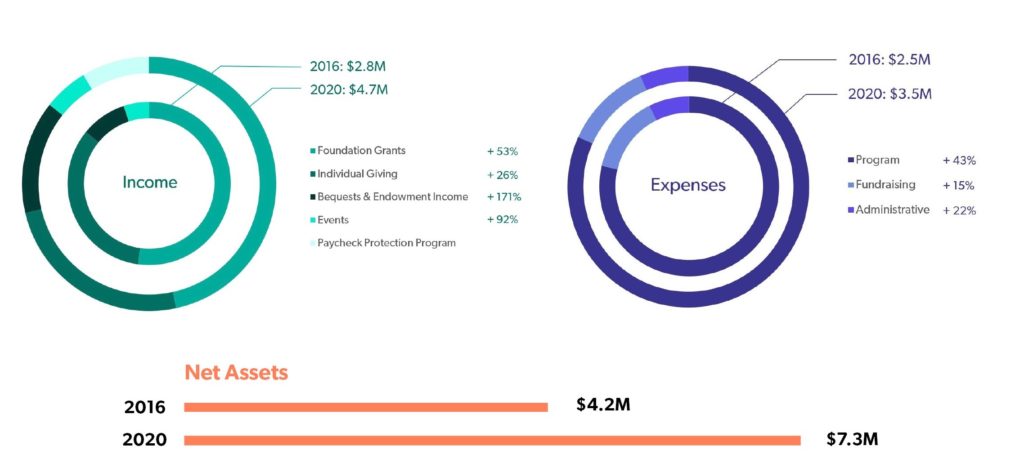
Communications
WEC’s robust communications team has substantially transformed the tools and strategies we use to tell our organizational story. Five years ago, our website and visual assets were a decade behind our peers and our social media presence was virtually non-existent. Now, we have strong branding and a dynamic, engaged presence on social media. We have built a broad platform for action, improved our credibility, and reached new audiences.
Our communications staff capacity and skill have played a critical role in advancing our mission during this Plan, from managing communications for multiple coalitions including the Climate Alliance for Jobs and Clean Energy, Stand Up To Oil, and Power Past Coal, driving public comment and contact with elected officials, to producing creative material in-house and coordinating media coverage and press briefings.
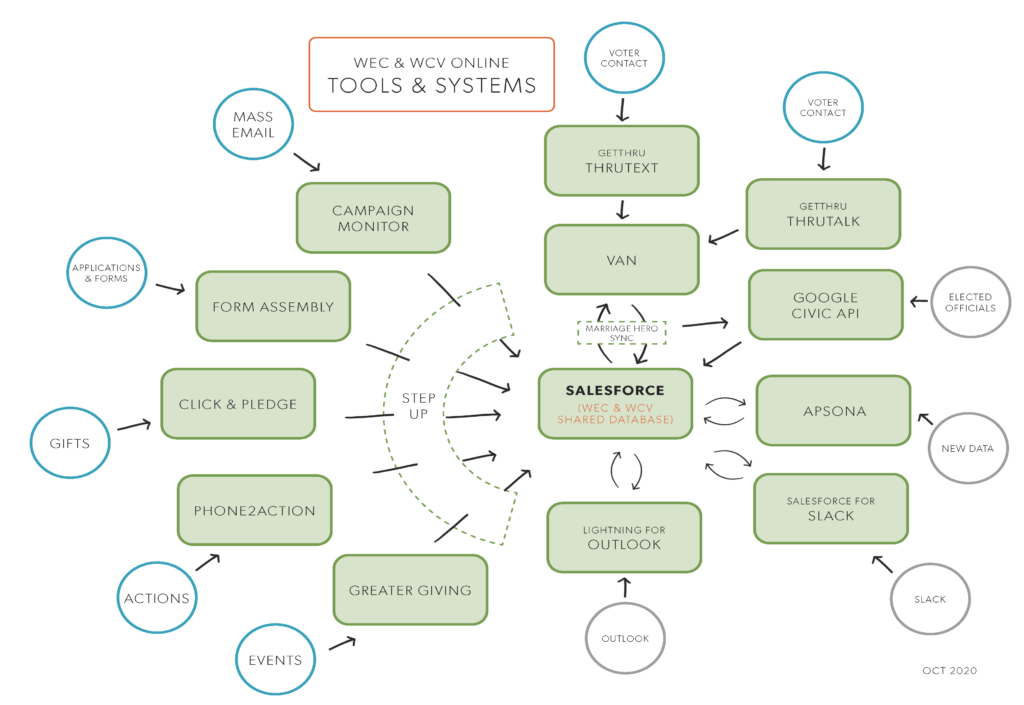
Data & Systems
We have made huge technological strides in the past five years. We upgraded and streamlined our fundraising, organizing, communications, and engagement tools in a centralized way. By integrating systems such as Phone2Action, Campaign Monitor, Form Assembly, and Voter Action Network into Salesforce, we have been able to improve member engagement and outreach.
The Voter Activation Network integration is particularly innovative. We are one of few organizations nationwide with this integration, allowing us to match and sync data from the voter file to member profiles in Salesforce. This has been instrumental for our organizing and voter engagement work.
Staff & Interns
We are investing in building and supporting the next generation of environmental leaders. We offer a paid internship program for young people to engage in environmental changemaking and develop concrete skills to support their careers moving forward.
We have developed multiple pathways for activists to engage at the level best suited to them, ranging from taking digital actions, to text or phone banking, to doorbell days, Lobby Day, and organizing other volunteers. We provide training and support for members and volunteers to grow into movement leaders.
We have grown and invested substantially in our staff. We have instituted a robust set of equitable hiring processes, increased salaries, and improved our already impressive benefits package designed to attract and retain our workforce.
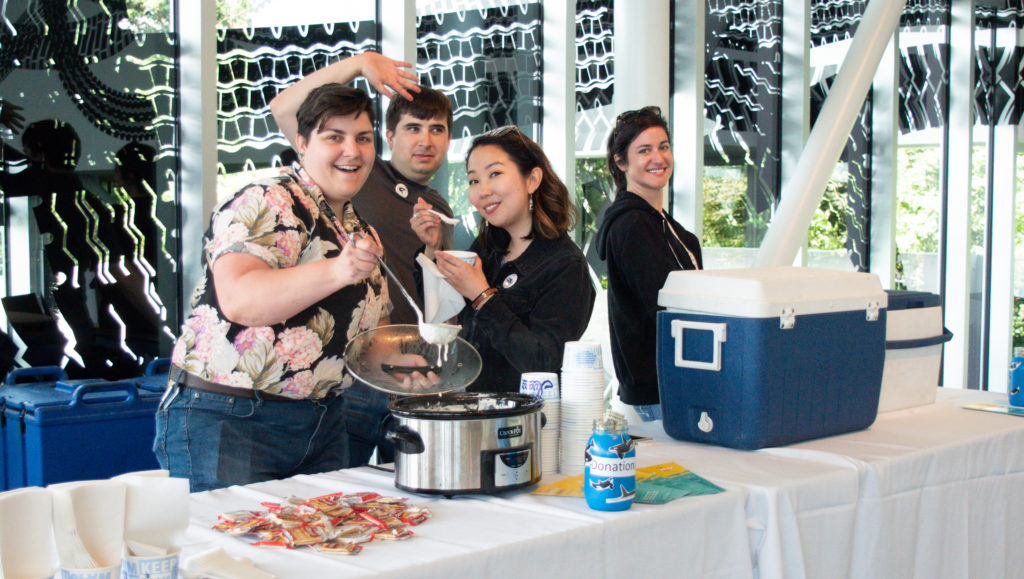
What were we able to accomplish due to these strong foundations & investments?
Flexibility & Efficacy
Our strong tools and systems helped us work effectively across multiple issue areas with strong coordination between our field and communications work, and improved member engagement and outreach. In the wake of the pandemic, we were able to smoothly transition to fully remote work, including internal organizational operations and external advocacy and organizing work.
Capacity to lead
Our financial stability allowed us to expand staff capacity in key areas over the life of this strategic plan, and with the pandemic we retained all of our staff and expanded benefits to support mental health and remote work. Our strong operations capacity also allowed WEC to support a number of coalitions in their operations, serving as fiscal sponsor, hosting and managing databases, streamlining organizing and advocacy tools, and providing fundraising and communications support.
Climate & Clean Energy
- 2018 Secured $80M for clean energy projects, building efficiency upgrades, & weatherization
- 2019 100% Clean Electricity
- 2019 Appliance efficiency
- 2019 Clean Buildings (commercial buildings statewide)
- 2019 Secured $340M in the state capital budget for environmental & climate projects
- 2020 Updated state GHG emission targets with new Climate Pollution Limits
- 2020 SEPA rulemaking on GHG emissions
- 2020 WSDOT budget proviso on Transportation For All
- 2021 Low Carbon Fuel Standard
- 2021 Climate Commitment Act
- 2021 HEAL Act
Fossil Fuel
Coal
- 2016 Gateway Pacific coal export terminal (Cherry Point, Bellingham, WA) defeated
- 2017 & 2018 Permits denied for Millennium Bulk Terminals (Longview, WA), & legal appeals denied
- 2019 Coal export facility at Fraser Surrey Docks (British Columbia) defeated
Oil
- 2015 Strengthened oil spill prevention law
- 2016 Whatcom County established moratorium on new fossil fuel projects
- 2016 Established ban on bulk oil terminals in Vancouver
- 2016 Shell Oil terminal (Anacortes, WA) defeated
- 2016 Waterside Energy refinery (Longview, WA) defeated
- 2016 U.S. Development Group oil terminal (Hoquiam, WA) defeated
- 2017 Westway Terminal Company’s proposed oil facility retrofit (Hoquiam, WA) defeated
- 2017 Imperium Renewables/Renewable Energy Group (REG)’s proposed oil facility retrofit (Hoquiam, WA) defeated
- 2017 NuStar Energy oil terminal retrofit (Vancouver, WA) defeated
- 2017 Established interim regulations in Tacoma barring new fossil fuel facilities
- 2017 Closed loophole for barrel tax and oil spill prevention laws
- 2018 North America’s largest proposed oil-by-rail terminal, Tesoro Savage (Vancouver, WA) defeated
- 2018 Secured oil spill prevention law addressing oil-by-rail and heavy sinking oils
- 2019 Secured oil spill prevention law requiring vessels carrying crude oil such as barges and smaller oil tankers to be escorted by a tug around the San Juan Islands.
- 2020 Strengthened Vancouver moratorium to prohibit all bulk fossil fuels
Gas
- 2020 Key permit denied for Jordan Cove LNG facility
- 2020 Key permit denied and major legal victory in federal lawsuit for Kalama Methanol facility
Puget Sound
- 2018 No Discharge Zone established
- 2018 Intervened in federal lawsuit against EPA to protect No Discharge Zone
- 2018 Secured $74M for Stormwater Financial Assistance Program investments
- 2018 MTCA racial equity and environmental justice criteria added to Public Participation Grants
- 2019 MTCA funding stabilized & increased
- 2019 Habitat protection law supporting Chinook salmon and forage fish populations by protecting shorelines and reducing invasive predatory species.
- 2019 Vessel noise and disturbance policy increasing the vessel buffer zone, reduces speed around orcas, and institutes commercial whale watch licensing and fees.
- 2019 Toxic pollution reduction law addressing classes of chemicals that impact vulnerable populations like children and sensitive species like orcas.
- 2019 Secured $250M for orca & salmon protection & recovery
- 2020 Won Clean Water Act lawsuit against U.S. Navy
Forestry
- 2016 Helped establish the Nisqually Carbon Project
- 2016 Secured changes to Clean Water State Revolving Fund to use for sustainable forestry
- 2018 Secured $18M in sustainable forestry funds for the Nisqually Community Forest, Columbia Land Trust, & Chimacum Ridge Community Forest
- 2019 Secured $4.6M for community forest projects in Ilwaco, Chewelah, & Mt. Adams
- 2020 Established Community Forests Program at the Recreation & Conservation Office
Voting Justice
- 2018 Automatic Voter Registration
- 2018 Same-day registration
- 2018 Pre-registration for 16 and 17 year olds
- 2019 Statewide Prepaid Postage
- 2019 Native American Voting Rights Act
- 2019 Ending Prison Gerrymandering
- 2019 Requiring Notification of Voting Right when being released from prison
- 2021 Restoring voting rights to formerly incarcerated people
The Story of Climate Progress
One of WEC’s core goals is to reduce dangerous climate pollution, moving our state away from reliance on fossil fuels in a way that results in cleaner air and water, increased economic opportunities, and a more just and equitable Washington. We often talk about this in terms of mutually reinforcing NO and YES work: saying “no” to any and all new investments in fossil fuels including establishing local land use policy barriers, and saying “yes” to clean energy solutions across the largest emitting sectors including the electricity grid, transportation, and buildings. We know that climate change and pollution have disproportionately negative impacts on communities of color, tribes, and low income people, and we are increasingly focused on the overlap of environmental protection and racial and economic equity in our work.
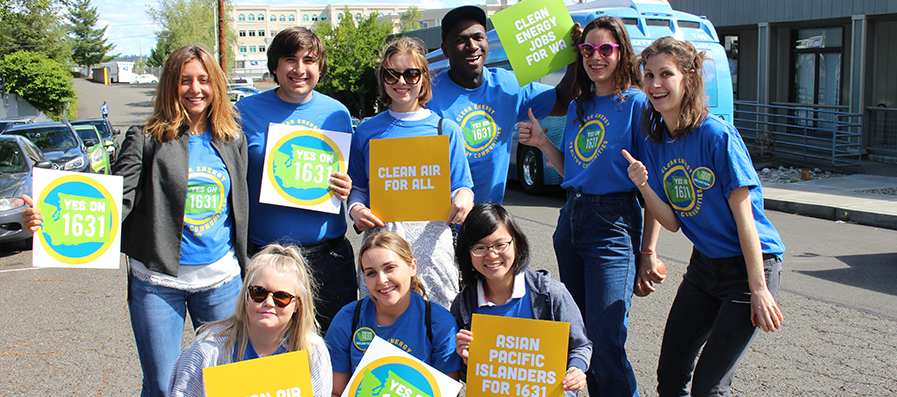
YES work
We made big strides in 2019 with the passage of 100% Clean Electricity. This landmark policy, one of the strongest in the nation, lays out a path to move utilities to clean energy and achieve a fossil fuel-free electricity grid in Washington by 2045 in a way that works for our climate, economy, workers, and communities. The environmental community was heavily divided the previous year on a similar bill, and WEC played a critical role navigating this rift throughout 2018 and re-aligning environmental organizations with communities of color and labor partners. With partners unified behind a single bill, and newly strengthened pro-environmental majorities in both the House and the Senate, WEC led the legislative effort to secure 100% Clean Electricity in 2019. We were able to move to the finish line by working in close collaboration with our partners to ensure strong cross-sector support and navigate the legislative landscape.
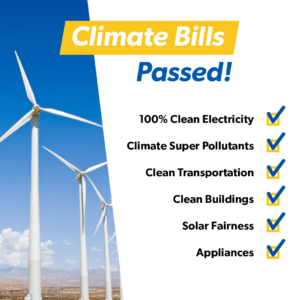
Much of the legwork behind 100% Clean came out of our work developing Initiative 1631 with our Climate Alliance for Jobs and Clean Energy partners (see Partnerships & Coalitions). The three pillars of 100% Clean — functionally reducing climate pollution, tying investment in clean energy facilities to strong labor standards, and addressing systemic racial and economic inequity — came directly out of the Climate Alliance’s policy framework. This vision for climate action mobilized the largest and most diverse coalition for a ballot measure in state history, with over 650 organizations, businesses, and Tribes and over 6,500 volunteers. Our work was also buoyed by the growing public appetite for action on climate, spurred by youth climate justice movements and the global climate strike. In just six years, we substantially shifted our state’s conversation around climate policy and demonstrated that securing a sustainable future for all Washingtonians requires durable, transformative solutions designed in collaboration with the people and communities who are most impacted by the issues — communities of color, tribes, and workers. Although we weren’t able to secure economy-wide emissions reductions through I-1631, we have been able to leverage the three key pillars as we tackle pollution in a sector by sector approach.
This framework drove the strong worker protections and equity provisions we incorporated into 100% Clean (addressing the utilities sector), and is the foundation of our approach to reducing emissions from buildings and our Transportation For All policy priorities. We also used this framework to incorporate strong intent language in the new Climate Pollution Limits passed in 2020 that aim for our state to reach net zero emissions by 2050. This language specifies that reductions must be done equitably and in a way that invests in Washington’s communities and workers. This was also the foundation of our multi-year advocacy around the HEAL Act, which codified environmental justice in state law.

NO work
In order to drive the shift toward a clean energy economy, we must keep the ever-adapting fossil fuel industry at bay until we have put in place strong, equitable, and sustainable solutions. Since 2010, we have stopped all proposed coal and oil projects in the region, fought expansions of gas infrastructure and pushed back against the use of gas in new buildings, and established local land use policy barriers in hot spot communities that are repeatedly targeted by the fossil fuel industry — Whatcom County, Vancouver, and Tacoma (see Policy Wins & Funding Secured).
Our victory in Vancouver against Tesoro Savage was a particularly high profile example of our model in action. That win depended heavily on our ability to coordinate communications, legal, policy, and field capacity, connect local project-specific issues to broader regional goals, and engage the public in collective action. Our C4 partnership also played a critical role — WCV helped elect two of the three Vancouver Port Commissioners who ultimately voted to deny a key project permit. Keeping these pieces moving strategically and efficiently forward has been essential to our success against the fossil fuel industry.
These broad regional campaigns are coordinated by partners within the Power Past Coal, Stand Up To Oil, and Power Past Fracked Gas coalitions. WEC plays a key leadership role as the fiscal sponsor and lead coordinating organization for the oil and coal coalitions, providing critical resources and capacity including managing day to day operations of the campaign. For the gas coalition, we serve on the collaborative team of partners leading the coalition and help guide strategy development for the campaign. WEC provides dedicated staff capacity toward communications and field organizing for both campaigns, and we host and manage the database that the coalitions use to engage the public. Collectively, we have submitted over 1 million comments over the last 10 years, driven record-breaking turnout to public hearings, and built a list of activists 30,000 strong across the region. Our coalitions have successfully demonstrated to the public and decision-makers that these proposals are more than just local battles; they have near-term impacts across the region and long-term impacts for global sustainability.
We are leveraging the anti-fossil fuel activist energy generated through these campaigns toward proactive planning for the clean energy economy. We have been working for several years with local governments and community interests in key geographies like Vancouver as they develop and update their Climate Action Plans under our state’s foundational land use planning law, the Growth Management Act. We are working to incorporate clean energy economic development and natural climate solutions in these plans so that local governments can better plan for continued growth in the decades to come while protecting the health and safety of their communities. This means setting strong emissions reduction goals with strategies tailored to each community’s unique needs, and continuing to expand in the coming years beyond our initial key geographies. This aspect of proactive climate action is also closely tied to Washington’s forests – now that natural climate solutions are included in state energy policy as part of how we achieve net zero by 2050, we can build carbon sequestration, forest carbon, and sustainable forest management into climate action plans.
The Story of Clean Water
Water is necessary for life, and clean water is integral to keeping our ecosystems balanced and functioning. The impacts of water pollution have far-reaching impacts for the well-being of people and planet. Understanding the threats to the health of the waterways and watersheds throughout Washington state and working together to address these from multiple angles is one of the most important environmental challenges we face in our regions.
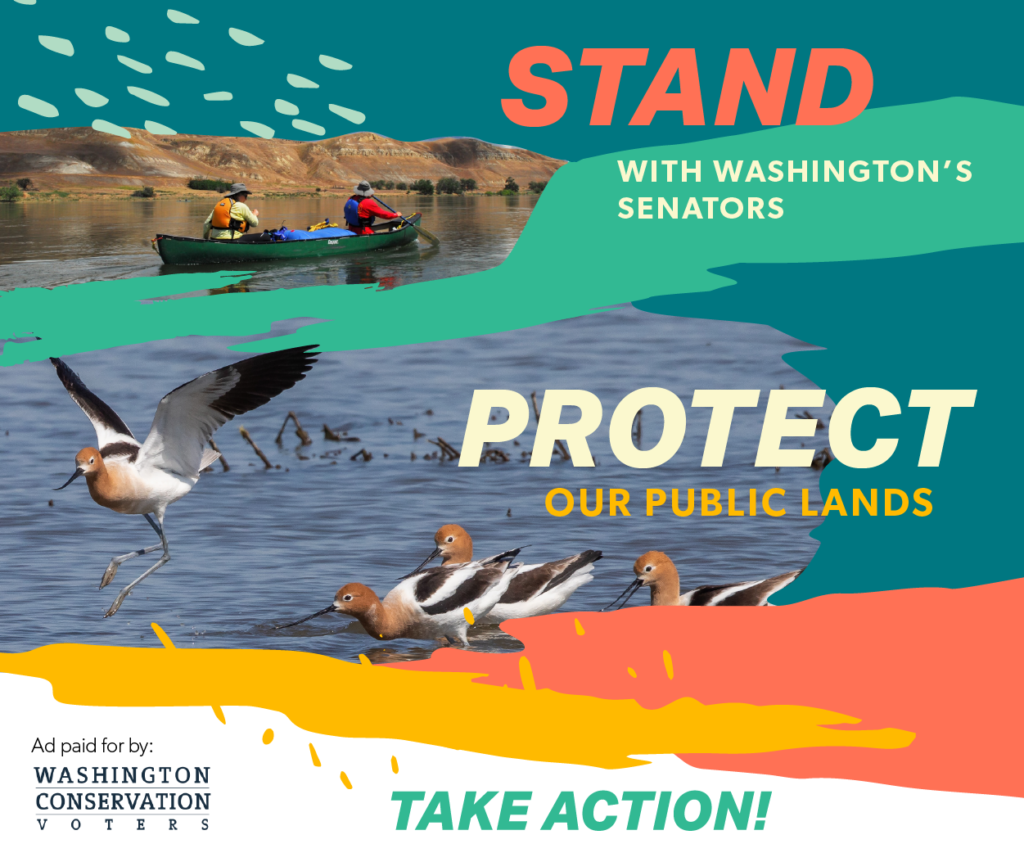
Public awareness and collective pressure for prioritizing clean water is how federal level funding and policy advocacy is possible. WEC and partners have tracked seven federal spending bills through two budget cycles, and utilized strategic storytelling to show decision makers and the public the value of federal clean water programs. Each year, WEC participates in Puget Sound Day On The Hill in Washington, D.C, meeting with members of the Washington delegation to advocate strong policy and funding for the protection of Puget Sound. During subsequent budget appropriations, Representative Kilmer secured a $3M increase in funding for Puget Sound, which was the largest percentage boost of any region.
We have also engaged our congressional delegation in our work to get the Land and Water Conservation Fund passed and permanently funded, a critical federal fund that has long served to restore and protect public lands and waters.
Sometimes the consequences of the decline of water quality is clear and evident to the public. Multiple orca deaths in 2018 caused unprecedented levels of public concern, especially after Tahlequah carried the body of her dead calf around Puget Sound for 17 days. WEC played a major role in advocating for addressing the critical threats to the Southern Resident orcas, such as vessel noise and toxic pollution. It is this level of public awareness that allowed the orca bills (see Policy Wins and Funding Secured) to pass readily through both chambers of the state legislature in 2019.
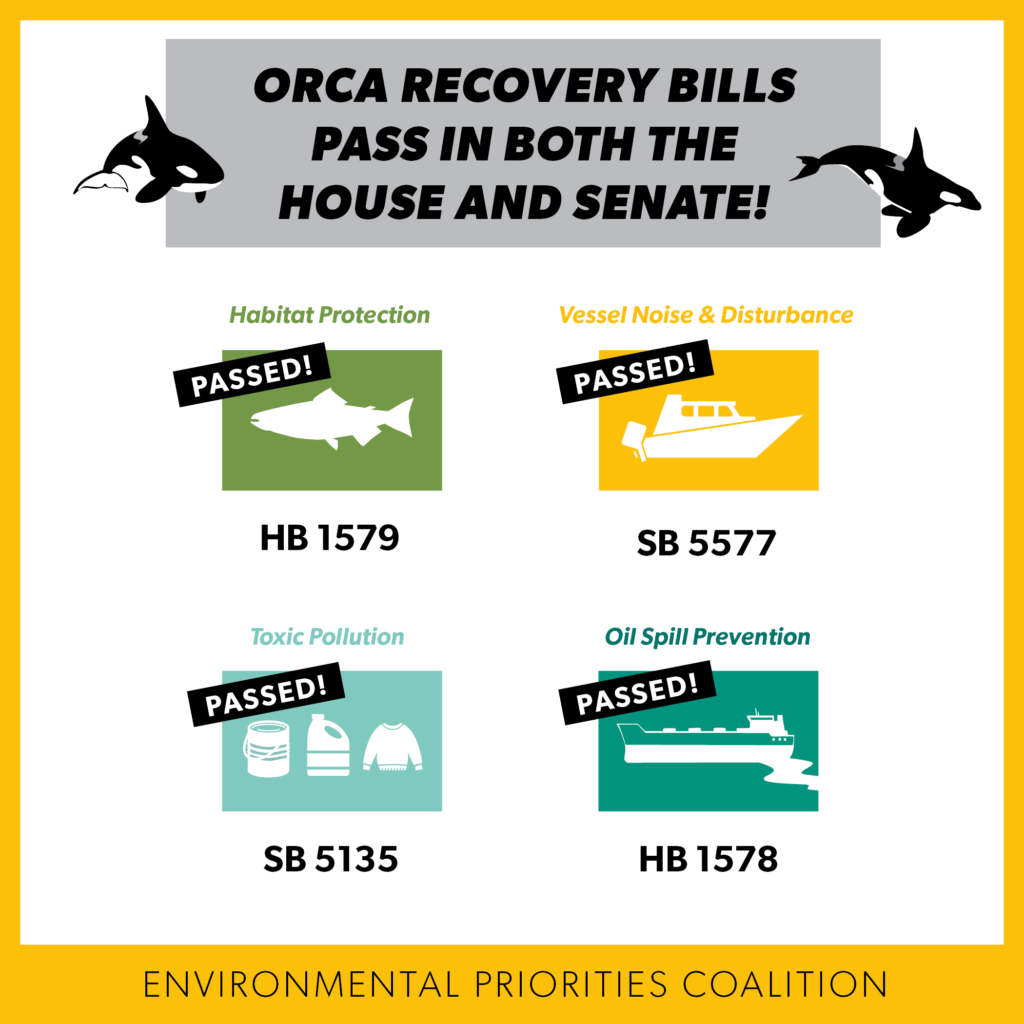

Orcas represent the accumulation of stressors on our aquatic ecosystems, reflective of far-ranging connections in our systems, human and ecological, that are harder to trace.
Though less commonly understood, the health of Puget Sound and the watershed is intricately tied to Washington’s forests. Take, for example, the massive decline of salmon stock, especially the Chinook. There are stressors that are readily apparent such as toxic pollution and the decline of forage fish due to increased shoreline armoring and dams.
However, salmon also have a reciprocal relationship with our forests — salmon bring nitrogen back to the forest ecosystem to ensure its health, and forested riparian zones (which are often under threat of development) directly affect the water quality of juvenile salmon freshwater habitats. A healthy riparian zone keeps stream temperatures low, filters pollutants, provides habitat for many species, and provides stability during flooding. Tribal Nations in the region have long understood the key connective role salmon plays in such ways, which underscores the importance of partnering with Tribes to apply traditional knowledge and management towards stewardship and planning. This includes projects such as the Kitsap Natural Resources Management (see Cross-Systems Change) and Local Climate Action Plans (see Multi-level Regional Strategies).
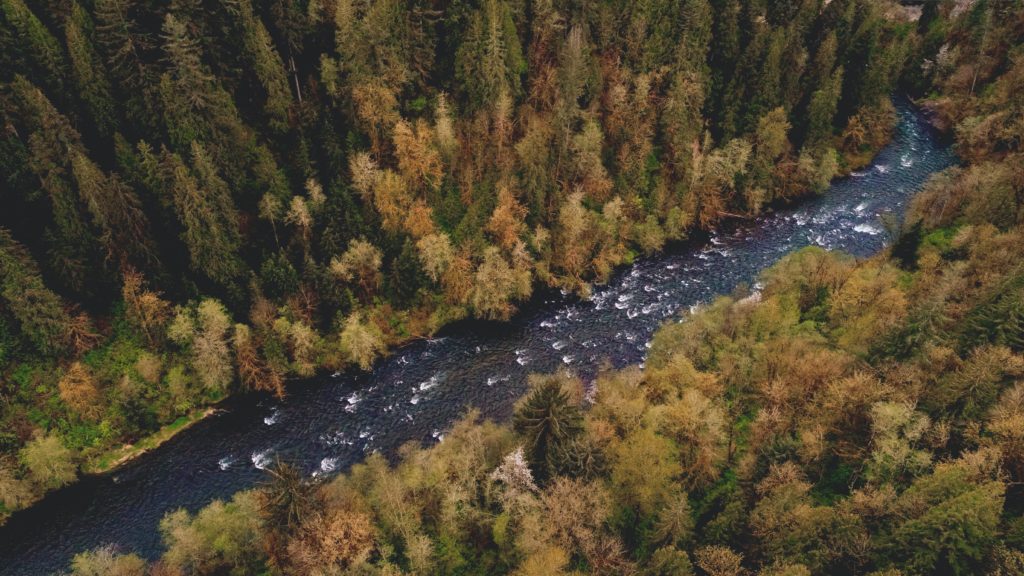
Clean water is directly linked with the health of our forests, which capture, filter, and retain water far more effectively than any human-made system for the same purposes. To that end, WEC worked to secure changes to the Clean Water State Revolving Fund that allows those dollars to be used for forestry projects that protect water quality. Historically, the funding has only been used for “gray” projects like water treatment facilities. With this change, there is now a large source of funding that can provide financial incentives for sustainable, smart forestry. So far, this program has funded forest projects in Pierce, Skamania, and other areas around the state.
When we pave over forest lands with impermeable surfaces and without careful consideration of how to preserve the functioning of the ecosystem, we compromise these abilities of the natural systems. Water that would otherwise be naturally filtered through soil passed over our roads, collecting pollutants, and goes straight into Puget Sound through our stormwater infrastructure. That is why WEC helped create and fund the Stormwater Financial Assistance Program, so that local governments had resources for clean water retrofit projects that prioritize green infrastructure. This program has since ranked and funded more than 300 projects across the state and has so far kept more than 1.5 million pounds of pollution from entering Washington’s waterways annually. In 2018, we helped to secure a new round of funding for the program in the capital budget, for a cumulative total of $208M secured since the first round of funding in 2013.
The above funding source, in conjunction with the Nature’s Scorecard program (see People Power and Accountability), ensures that our municipalities are partners and collaborators in sustainable development that limits stormwater pollution from collecting and entering our waterways.

Finally, we must also limit excess production of pollutants on the road. When WEC participates in advocating for public transportation investments alongside EPC coalition members, we are taking part in protecting clean water, orcas, and salmon for healthy communities. To this end, WEC and partners worked on public education campaigns, such as the “Be an Orca Hero” campaign during transit month which highlighted these interconnections and was featured by King County Metro. Now the campaign has been incorporated as part of the Orcas Love Raingarden curriculum in Tacoma schools.
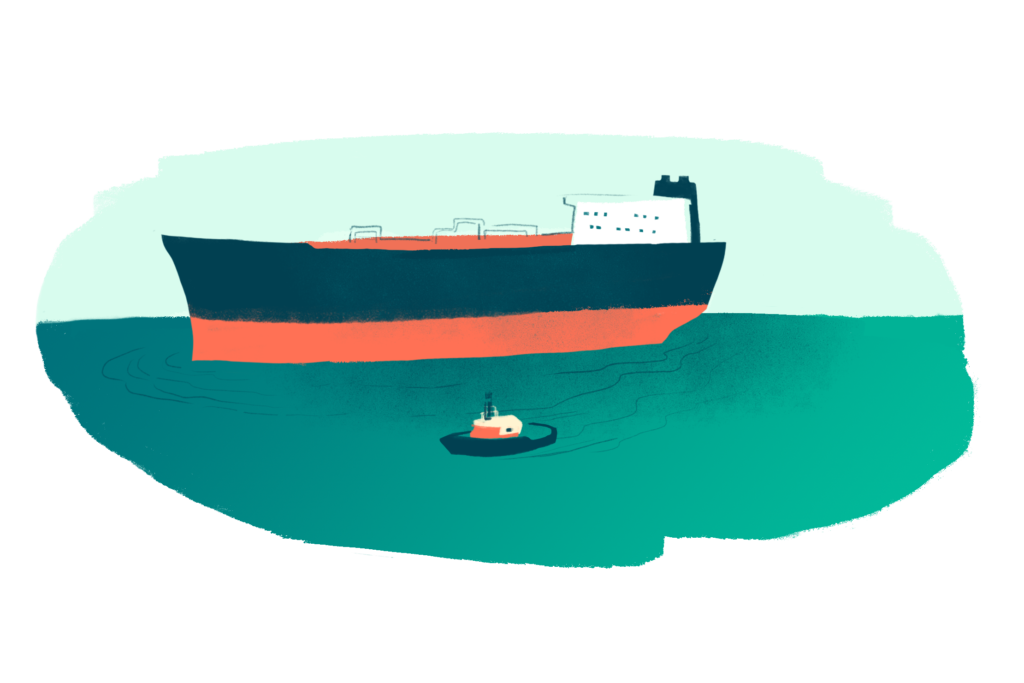
The extraction and processing of fossil fuels, as well as the infrastructure that transports it through a region, can have profound impacts on the water quality and the health of the environment.
The far reaching impacts of oil spills are widely acknowledged. We secured oil spill prevention measures in 2014, 2015, 2018, and 2019 and engaged in subsequent rulemakings and public engagement processes, including:
- updates to state’s barrel tax to apply to all modes of transport (pipeline, vessel & train),
- more stable barrel tax amount,
- public disclosure and publicly available reporting of oil transport information and trends,
- series of new protection laws to strengthen oil spill prevention and preparedness,
- and stronger insurance requirements on fossil fuel industry.
What is less acknowledged are the immediate impacts of fossil fuel infrastructure on the surrounding communities. Though our region is more often targeted for export terminals to transport products by waterways, the end of a chain that begins in Canada, these facilities (the Tacoma LNG plant as merely one example) pose a danger to the surrounding communities through possible accidents and groundwater contamination.
Industrial and historical groundwater contamination continues to have an impact on the health of communities. For instance, 56 percent of the toxic sites that were identified through the Model Toxic Control Act (MTCA) are located in low-income communities and 46 percent are located in communities of color (Front & Centered). MTCA represents a part of WEC’s history, and, in its 32 years, has successfully cleaned up over 7,000 sites throughout the state, and prevented many other sources of pollution that harm our communities by poisoning our water, air, and land. MTCA’s broad success demonstrates how this law serves as one of the most important tools for environmental protection here in Washington.
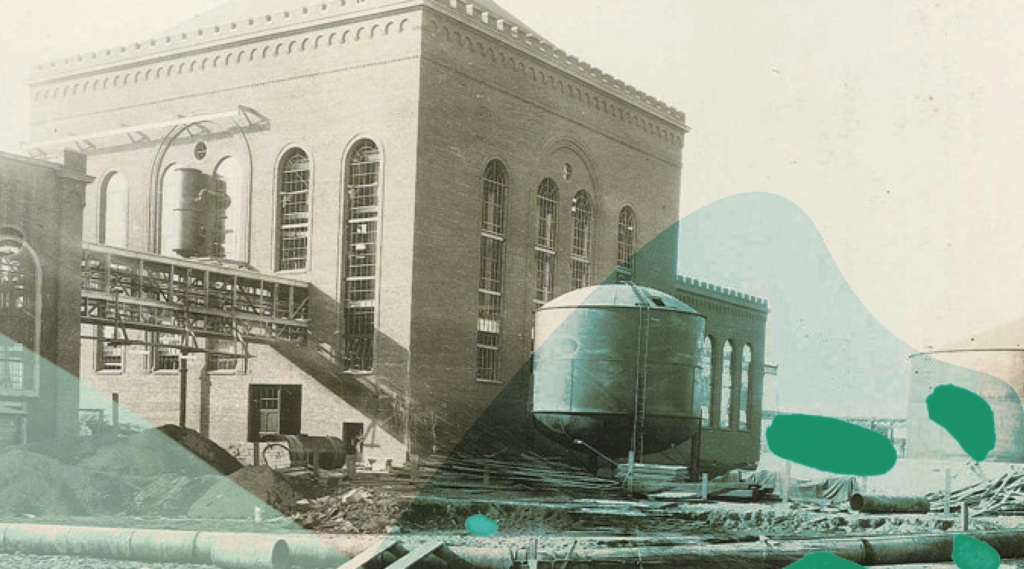
However, many sites remained unaddressed, due to funding gaps. Passed in 1988, MTCA’s funding mechanism — tied to the price of oil — was volatile and could not keep up with the demand to fund clean-up and prevention efforts. Additionally, the use of the funding wasn’t always directed to the most impacted communities. As lots remained vacant — a hurdle to development because sites required clean up — and communities continued to be harmed by toxics and underinvestment, there was a critical need to shore up the existing funding systems to adequately address the opportunity gaps created by historical injustices.
During the 2019 legislative session, WEC worked to push the state legislature to address these gaps in the initial MTCA law and ensure that the Polluter Pays model adequately covers the need for cleanup and prevention funding. We provided key leadership to stabilize MTCA’s funding source, resulting in increased funding from approximately $315M to $475M per biennium. WEC and our partners also secured important changes before the funding was stabilized that incorporated environmental justice and racial equity into how the funding is applied, and as a result, many community of color led groups were awarded first-time MTCA grants in 2017.
These successes were possible due to the convergence of several factors, which serve as an illustrative case-study for how WEC works to institute change: 1) when public participation grants were zeroed out in 2015 due to lack of funding, WEC built a coalition of frontline community groups, local governments, and other allies like low-income housing developers to work together and advocate changes to the law; 2) we leveraged Front & Centered’s 2016 equity analysis to show officials that toxic polluted sites are disproportionately located in communities of color and low-income areas across Washington; and 3) key elected officials resolved to fix the problems and we provided them with input from the public and other stakeholders, highlighting the community impacts that occur from a lack of funding and project delays.
Historical toxic pollution from many decades ago continues to have significant reverberations today, in water quality, healthy habitats, housing, economics, perpetuation of inequities, and community health. These impacts are a sobering reminder that we must continue to challenge the false narrative that our actions and our lives are somehow separate from the environment.
Clean Water
Water is necessary for life, and clean water is integral to keeping our ecosystems balanced and functioning. The impacts of water pollution have far-reaching impacts for the well-being of people and planet. Understanding the threats to the health of the waterways and watersheds throughout Washington state and working together to address these from multiple angles is one of the most important environmental challenges we face in our regions.
Public awareness and collective pressure for prioritizing clean water is how federal level funding and policy advocacy is possible. WEC and partners have tracked seven federal spending bills through two budget cycles, and utilized strategic storytelling to show decision makers and the public the value of federal clean water programs. Each year, WEC participates in Puget Sound Day On The Hill in Washington, D.C, meeting with members of the Washington delegation to advocate strong policy and funding for the protection of Puget Sound. During subsequent budget appropriations, Representative Kilmer secured a $3M increase in funding for Puget Sound, which was the largest percentage boost of any region. We have also engaged our congressional delegation in our work to get the Land and Water Conservation Fund passed and permanently funded, a critical federal fund that has long served to restore and protect public lands and waters.
Sometimes the consequences of the decline of water quality is clear and evident to the public. Multiple orca deaths in 2018 caused unprecedented levels of public concern, especially after Tahlequah carried the body of her dead calf around Puget Sound for 17 days. WEC played a major role in advocating for addressing the critical threats to the Southern Resident orcas, such as vessel noise and toxic pollution. It is this level of public awareness that allowed the orca bills (see Policy Wins and Funding Secured) to pass readily through both chambers of the state legislature in 2019.
Orcas represent the accumulation of stressors on our aquatic ecosystems, reflective of far-ranging connections in our systems, human and ecological, that are harder to trace.
Though less commonly understood, the health of Puget Sound and the watershed is intricately tied to Washington’s forests. Take, for example, the massive decline of salmon stock, especially the Chinook. There are stressors that are readily apparent such as toxic pollution and the decline of forage fish due to increased shoreline armoring and dams. However, salmon also have a reciprocal relationship with our forests – salmon bring nitrogen back to the forest ecosystem to ensure its health, and forested riparian zones (which are often under threat of development) directly affect the water quality of juvenile salmon freshwater habitats. A healthy riparian zone keeps stream temperatures low, filters pollutants, provides habitat for many species, and provides stability during flooding. Tribal Nations in the region have long understood the key connective role salmon plays in such ways, which underscores the importance of partnering with Tribes to apply traditional knowledge and management towards stewardship and planning. This includes projects such as the Kitsap Natural Resources Management (see Cross-Systems Change) and Local Climate Action Plans (see Multi-level Regional Strategies).
Clean water is directly linked with the health of our forests, which capture, filter, and retain water far more effectively than any human-made system for the same purposes. To that end, WEC worked to secure changes to the Clean Water State Revolving Fund that allows those dollars to be used for forestry projects that protect water quality. Historically, the funding has only been used for “gray” projects like water treatment facilities. With this change, there is now a large source of funding that can provide financial incentives for sustainable, smart forestry. So far, this program has funded forest projects in Pierce, Skamania, and other areas around the state.
When we pave over forest lands with impermeable surfaces and without careful consideration of how to preserve the functioning of the ecosystem, we compromise these abilities of the natural systems. Water that would otherwise be naturally filtered through soil passed over our roads, collecting pollutants, and goes straight into Puget Sound through our stormwater infrastructure. That is why WEC helped create and fund the Stormwater Financial Assistance Program, so that local governments had resources for clean water retrofit projects that prioritize green infrastructure. This program has since ranked and funded more than 300 projects across the state and has so far kept more than 1.5 million pounds of pollution from entering Washington’s waterways annually. In 2018, we helped to secure a new round of funding for the program in the capital budget, for a cumulative total of $208M secured since the first round of funding in 2013.
The above funding source, in conjunction with the Nature’s Scorecard program (see People Power and Accountability), ensures that our municipalities are partners and collaborators in sustainable development that limits stormwater pollution from collecting and entering our waterways.
Finally, we must also limit excess production of pollutants on the road. When WEC participates in advocating for public transportation investments alongside EPC coalition members, we are taking part in protecting clean water, orcas, and salmon for healthy communities. To this end, WEC and partners worked on public education campaigns, such as the “Be an Orca Hero” campaign during transit month which highlighted these interconnections and was featured by King County Metro. Now the campaign has been incorporated as part of the Orcas Love Raingarden curriculum in Tacoma schools.
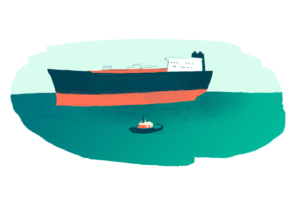
The extraction and processing of fossil fuels, as well as the infrastructure that transports it through a region, can have profound impacts on the water quality and the health of the environment.
The far reaching impacts of oil spills are widely acknowledged. We secured oil spill prevention measures in 2014, 2015, 2018, and 2019 and engaged in subsequent rulemakings and public engagement processes, including:
- updates to state’s barrel tax to apply to all modes of transport (pipeline, vessel & train),
- more stable barrel tax amount,
- public disclosure and publicly available reporting of oil transport information and trends,
- series of new protection laws to strengthen oil spill prevention and preparedness,
- and stronger insurance requirements on fossil fuel industry.
What is less acknowledged are the immediate impacts of fossil fuel infrastructure on the surrounding communities. Though our region is more often targeted for export terminals to transport products by waterways, the end of a chain that begins in Canada, these facilities (the Tacoma LNG plant as merely one example) pose a danger to the surrounding communities through possible accidents and groundwater contamination.
Industrial and historical groundwater contamination continues to have an impact on the health of communities. For instance, 56 percent of the toxic sites that were identified through the Model Toxic Control Act (MTCA) are located in low-income communities and 46 percent are located in communities of color (link to F&C). MTCA represents a part of WEC’s history, and, in its 32 years, has successfully cleaned up over 7,000 sites throughout the state, and prevented many other sources of pollution that harm our communities by poisoning our water, air, and land. MTCA’s broad success demonstrates how this law serves as one of the most important tools for environmental protection here in Washington.
However, many sites remained unaddressed, due to funding gaps. Passed in 1988, MTCA’s funding mechanism—tied to the price of oil—was volatile and could not keep up with the demand to fund clean-up and prevention efforts.
Additionally, the use of the funding wasn’t always directed to the most impacted communities. As lots remained vacant—a hurdle to development because sites required clean up—and communities continued to be harmed by toxics and underinvestment, there was a critical need to shore up the existing funding systems to adequately address the opportunity gaps created by historical injustices.
During the 2019 legislative session, WEC worked to push the state legislature to address these gaps in the initial MTCA law and ensure that the Polluter Pays model adequately covers the need for cleanup and prevention funding. We provided key leadership to stabilize MTCA’s funding source, resulting in increased funding from approximately $315M to $475M per biennium. WEC and our partners also secured important changes before the funding was stabilized that incorporated environmental justice and racial equity into how the funding is applied, and as a result, many community of color led groups were awarded first-time MTCA grants in 2017.
These successes were possible due to the convergence of several factors, which serve as an illustrative case-study for how WEC works to institute change: 1) when public participation grants were zeroed out in 2015 due to lack of funding, WEC built a coalition of frontline community groups, local governments, and other allies like low-income housing developers to work together and advocate changes to the law; 2) we leveraged Front & Centered’s 2016 equity analysis to show officials that toxic polluted sites are disproportionately located in communities of color and low-income areas across Washington; and 3) key elected officials resolved to fix the problems and we provided them with input from the public and other stakeholders, highlighting the community impacts that occur from a lack of funding and project delays.
Historical toxic pollution from many decades ago continues to have significant reverberations today, in water quality, healthy habitats, housing, economics, perpetuation of inequities, and community health. These impacts are a sobering reminder that we must continue to challenge the false narrative that our actions and our lives are somehow separate from the environment.
One of WEC’s core goals is to reduce dangerous climate pollution, moving our state away from reliance on fossil fuels in a way that results in cleaner air and water, increased economic opportunities, and a more just and equitable Washington. We often talk about this in terms of mutually reinforcing NO and YES work: saying “no” to any and all new investments in fossil fuels including establishing local land use policy barriers, and saying “yes” to clean energy solutions across the largest emitting sectors including the electricity grid, transportation, and buildings. We know that climate change and pollution have disproportionately negative impacts on communities of color, tribes, and low income people, and we are increasingly focused on the overlap of environmental protection and racial and economic equity in our work.
We made big strides in 2019 with the passage of 100% Clean Electricity. This landmark policy, one of the strongest in the nation, lays out a path to move utilities to clean energy and achieve a fossil fuel-free electricity grid in Washington by 2045 in a way that works for our climate, economy, workers, and communities. The environmental community was heavily divided the previous year on a similar bill, and WEC played a critical role navigating this rift throughout 2018 and re-aligning environmental organizations with communities of color and labor partners. With partners unified behind a single bill, and newly strengthened pro-environmental majorities in both the House and the Senate, WEC led the legislative effort to secure 100% Clean Electricity in 2019. We were able to move to the finish line by working in close collaboration with our partners to ensure strong cross-sector support and navigate the legislative landscape.
Much of the legwork behind 100% Clean came out of our work developing Initiative 1631 with our Climate Alliance for Jobs and Clean Energy partners (see Partnerships & Coalitions). The three pillars of 100% Clean – functionally reducing climate pollution, tying investment in clean energy facilities to strong labor standards, and addressing systemic racial and economic inequity – came directly out of the Climate Alliance’s policy framework. This vision for climate action mobilized the largest and most diverse coalition for a ballot measure in state history, with over 650 organizations, businesses, and Tribes and over 6,500 volunteers. Our work was also buoyed by the growing public appetite for action on climate, spurred by youth climate justice movements and the global climate strike. In just six years, we substantially shifted our state’s conversation around climate policy and demonstrated that securing a sustainable future for all Washingtonians requires durable, transformative solutions designed in collaboration with the people and communities who are most impacted by the issues – communities of color, tribes, and workers. Although we weren’t able to secure economy-wide emissions reductions through I-1631, we have been able to leverage the three key pillars as we tackle pollution in a sector by sector approach.
This framework drove the strong worker protections and equity provisions we incorporated into 100% Clean (addressing the utilities sector), and is the foundation of our approach to reducing emissions from buildings and our Transportation For All policy priorities. We also used this framework to incorporate strong intent language in the new Climate Pollution Limits passed in 2020 that aim for our state to reach net zero emissions by 2050. This language specifies that reductions must be done equitably and in a way that invests in Washington’s communities and workers. This was also the foundation of our multi-year advocacy around the HEAL Act, which codified environmental justice in state law.
Understanding the threats to the health of the waterways and watersheds throughout Washington state and working together to address these from multiple angles is one of the most important environmental challenges we face in our regions.
Public awareness and collective pressure for prioritizing clean water is how federal level funding and policy advocacy is possible. WEC and partners have tracked seven federal spending bills through two budget cycles, and utilized strategic storytelling to show decision makers and the public the value of federal clean water programs. Each year, WEC participates in Puget Sound Day On The Hill in Washington, D.C, meeting with members of the Washington delegation to advocate strong policy and funding for the protection of Puget Sound. During subsequent budget appropriations, Representative Kilmer secured a $3M increase in funding for Puget Sound, which was the largest percentage boost of any region. We have also engaged our congressional delegation in our work to get the Land and Water Conservation Fund passed and permanently funded, a critical federal fund that has long served to restore and protect public lands and waters.
Sometimes the consequences of the decline of water quality is clear and evident to the public. Multiple orca deaths in 2018 caused unprecedented levels of public concern, especially after Tahlequah carried the body of her dead calf around Puget Sound for 17 days. WEC played a major role (see pg X) in advocating for addressing the critical threats to the SKWR, such as vessel noise and toxic pollution. It is this level of public awareness that allowed the orca bills (see appx) pushed through both chambers of the State Legislature with alacrity in 2019.
But the orcas also represent the accumulation of stressors on our aquatic ecosystems that represent the far-ranging connections in our systems, human and ecological, that are harder to trace.
Though less commonly understood, the health of Puget Sound and the watershed is intricately tied to Washington’s forests. Take, for example, the massive decline of salmon stock, especially the Chinook. There are stressors that are more apparent (toxic pollution, decline of forage fish due to increased shoreline armoring, dams), but less obvious are how the salmon bring nitrogen back to the forest ecosystem to ensure its health, and the impact of development on riparian zones—which lower temperatures, filter pollutants, provide habitat for many species, provide stability during flooding—and the water quality of the freshwater habitats on juvenile salmon. Tribal Nations in the region have long understood the key connective role salmon plays in such ways, which underscores the importance of partnering with Tribes to apply traditional knowledge and management towards stewardship and planning. This includes projects such as the Kitsap Natural Resources Management (see pg X) and Local Climate Action Plans (see X).
Clean water is directly linked with the health of our forests, which capture, filter, and retain water, far more effectively than any human-made system for the same purposes. To that end, WEC worked to secure changes to the Clean Water State Revolving Fund that allows those dollars to be used for forestry projects that protect water quality. Historically, the funding has only been used for “gray” projects like water treatment facilities. With this change, there is now a large source of funding that can provide financial incentives for sustainable, smart forestry. So far, this program has funded forest projects in Pierce, Skamania,
When we pave over forest lands with impermeable surfaces and without careful consideration of how to preserve the functioning of the ecosystem, we compromise these abilities of the natural systems.
And, too, the water that would naturally be filtered pass over our roads, collecting pollutants, and go straight into Puget Sound through our stormwater infrastructure. That is why WEC helped create and fund the Stormwater Financial Assistance Program, so that local governments had resources for clean water retrofit projects that prioritize green infrastructure. This program has since ranked and funded more than 300 projects across the state and has so far kept more than 1.5 million pounds of pollution from entering Washington’s waterways annually. In 2018, we helped to secure a new round of funding for the grant program totaling $73.6M in the capital budget, for a cumulative total of $208M secured since the first round of funding in 2013.
The above funding source, in conjunction with the Nature Scorecard program (see pg. X), ensures that our municipalities are partners and collaborators in sustainable development that limits stormwater pollution from collecting and entering our waterways.
We must also limit excess production of pollutants on the road. When WEC takes part in advocating for public transportation investments alongside EPC coalition members, we are taking part in protecting clean water, the orcas, the salmon, and for healthy communities. To this end, WEC and partners worked on public education campaigns, such as the “Be an Orca Hero” campaign during transit month, highlighting these ties, featured by Metro, now part of the Orcas Love Raingarden curriculum in Tacoma schools.
The extraction and processing of fossil fuels, as well as the infrastructure that transports it through a region, can have profound impacts on the water quality and the health of the environment.
The far reaching impacts of oil spills are widely acknowledged. We secured oil spill prevention measures in 2014, 2015, 2018, and 2019 and engaged in subsequent rulemakings and public engagement processes, including: update to state’s barrel tax to apply to all modes of transport (pipeline, vessel & train), more stable barrel tax amount, public disclosure and publically available reporting of oil transport information and trends, series of new protection laws to strengthen oil spill prevention and preparedness, and stronger insurance requirements on fossil fuel industry.
What is less acknowledged are the immediate impacts of fossil fuel infrastructure on the surrounding communities. Though our region is more often targeted for export terminals to transport products by waterways, the end of a chain that begins in Canada, these facilities (the Tacoma LNG plant as merely one example) pose a danger to the surrounding communities through possible accidents and groundwater contamination.
This type of industrial and historical groundwater contamination continues to have an impact on the health of communities; for instance, 56 percent of the toxic sites that were identified through the Model Toxic Control Act (MTCA) are located in low-income communities and 46 percent are located in communities of color (link to F&C). MTCA represents a part of WEC’s history, and, in its 32 years, has successfully cleaned up over 7,000 sites throughout the state, and prevented many other sources of pollution that harm our communities by poisoning our water, air, and land; its broad success demonstrates how this law serves as one of the most important tools for environmental protection here in Washington.
However, many sites remained unaddressed, due to funding gaps. Passed in 1988, MTCA’s funding mechanism—tied to the price of oil—was volatile and could not keep up with the demand to fund clean-up and prevention efforts. Additionally, the use of the funding wasn’t always directed to the most impacted communities. And as lots remained vacant–hurdles to development due to sites requiring clean up–and communities continued to be harmed by toxics and underinvestment, there was a critical need to shore up the existing funding systems to adequately address these opportunity gaps created by historical injustices.
During the 2019 legislative session, WEC worked to push the State Legislature to address these funding gaps in the initial MTCA law and ensure that the Polluter Pays model adequately covers the need, which far outstrips the original estimate, providing key leadership to stabilize MTCA’s funding source, resulting in increased funding from approximately $315M to $475M per biennium. WEC and our partners also secured important changes before the funding was stabilized that incorporated environmental justice and racial equity into how the funding is applied, and as a result, many community of color led groups were awarded first-time MTCA grants in 2017.
These successes were possible due to the convergence of several factors, which serve as an illustrative case-study for how WEC works to institute change:
- when public participation grants were zeroed out in 2015 due to lack of funding, WEC built a coalition of frontline community groups, local governments, and other allies like low-income housing developers to work together to advocate changes to the law;
- we leveraged Front & Centered’s 2016 equity analysis to show officials concretely what is at stake: toxic polluted sites are disproportionately located in communities of color and low-income areas across Washington; and
- key elected officials resolved to fix the problems and we were able to provide them with input from the public and other stakeholders, highlighting the impact to their communities tied to the lack of funding and project delays.
Seeing the impacts of historical toxic pollution from many decades ago that continue to have significant reverberations today, in water quality, healthy habitats, housing, economics, perpetuation of inequities, and community health, is a sobering reminder that we must continue to challenge the false narrative that our actions and our lives are somehow apart from the environment.
As an organization committed to societal change, these past five years have been a time of intense advocacy and deep reflection
Your tax-deductible donation ensures a sustainable future.
